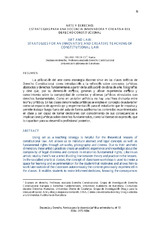Arte y Derecho: estrategias para una docencia innovadora y creativa del Derecho constitucional
Art and Law: strategies for an innovative and creative teaching of constitutional Law
Autor
Saura Freixes, Nuria
Editor
UCOPressFecha
2019Materia
Innovación docenteDerecho constitucional
Arte
METS:
Mostrar el registro METSPREMIS:
Mostrar el registro PREMISMetadatos
Mostrar el registro completo del ítemResumen
La utilización del arte como estrategia docente sirve en las clases teóricas de Derecho Constitucional como introducción a la reflexión sobre conceptos jurídicos abstractos y derechos fundamentales a partir de la utilización de obras de arte, fotografías y cine que, por su dimensión estética, generan y aúnan experiencia estética y conocimiento sobre la complejidad de contextos y dilemas jurídicos vinculados con derechos fundamentales. Como en un taller artístico, no hay una línea divisoria entre teoría y práctica. En las clases denominadas prácticas se emplea el concepto de aula-taller como un espacio de aprendizaje y experimentación para el estudiante que le impulsa y permite trabajar luego fuera del aula de forma autónoma los contenidos experimentados en clase y ser capaz de tomar decisiones con conocimiento de sus consecuencias e implicaciones jurídicas sobre derechos fundamentales, como la libertad de expresión, que lo capacitan para su desarrollo profesional posterior. Using art as a teaching strategy is helpful for the theoretical lessons of constitutional law. Art allows us to introduce abstract and legal concepts as well as fundamental rights through art works, photography and cinema. Due to their aesthetic dimension, these artistic practices create an aesthetic experience and knowledge about the complexity of legal dilemma and contexts in relation to fundamental rights. Like in an artistic studio, there’s not a strict dividing line between theory and practice in the lessons. In the so-called practical classes, the concept of classroom-workshop is used to create a space for learning and experimentation for the student that motivates and allows him to work later outside of the classroom autonomously the contents previously experienced in the classes. It enables students to make informed decisions, knowing the consequences and legal implications on fundamental rights, such as freedom of expression, empowering them for further professional development.

